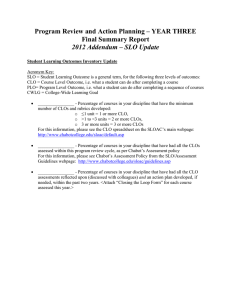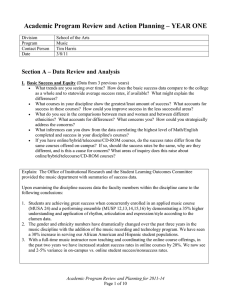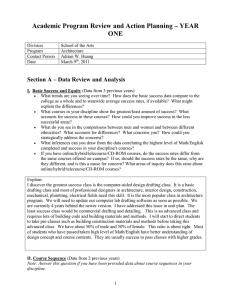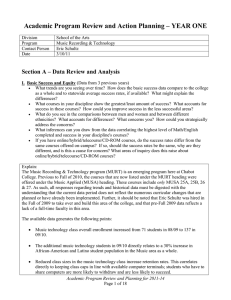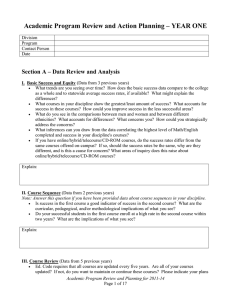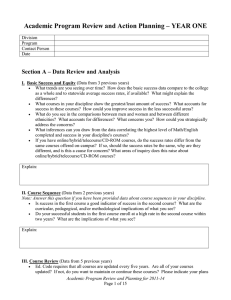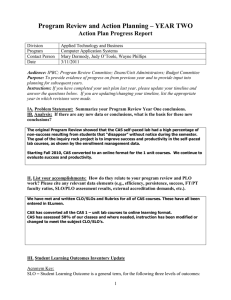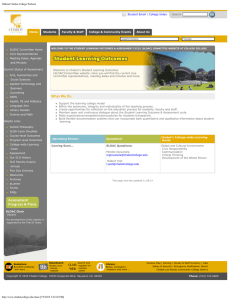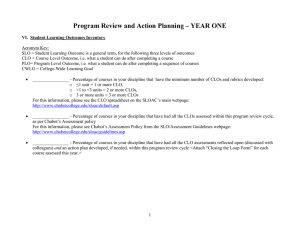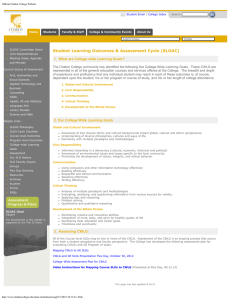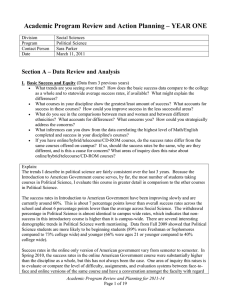Academic Program Review and Action Planning – YEAR ONE
advertisement
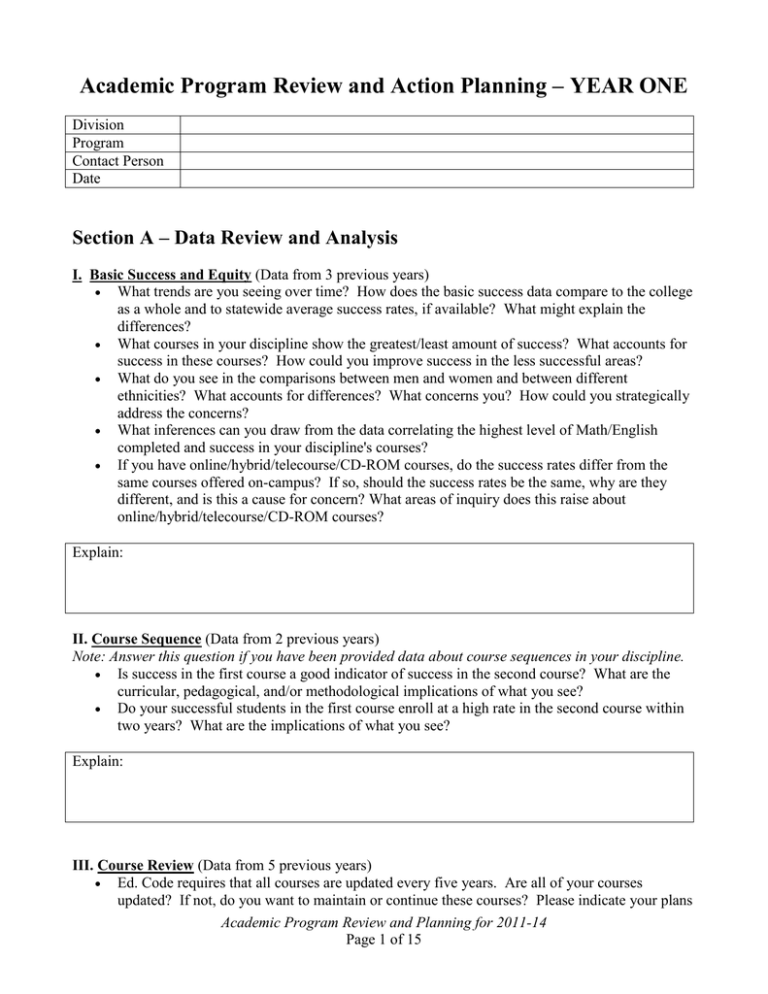
Academic Program Review and Action Planning – YEAR ONE Division Program Contact Person Date Section A – Data Review and Analysis I. Basic Success and Equity (Data from 3 previous years) What trends are you seeing over time? How does the basic success data compare to the college as a whole and to statewide average success rates, if available? What might explain the differences? What courses in your discipline show the greatest/least amount of success? What accounts for success in these courses? How could you improve success in the less successful areas? What do you see in the comparisons between men and women and between different ethnicities? What accounts for differences? What concerns you? How could you strategically address the concerns? What inferences can you draw from the data correlating the highest level of Math/English completed and success in your discipline's courses? If you have online/hybrid/telecourse/CD-ROM courses, do the success rates differ from the same courses offered on-campus? If so, should the success rates be the same, why are they different, and is this a cause for concern? What areas of inquiry does this raise about online/hybrid/telecourse/CD-ROM courses? Explain: II. Course Sequence (Data from 2 previous years) Note: Answer this question if you have been provided data about course sequences in your discipline. Is success in the first course a good indicator of success in the second course? What are the curricular, pedagogical, and/or methodological implications of what you see? Do your successful students in the first course enroll at a high rate in the second course within two years? What are the implications of what you see? Explain: III. Course Review (Data from 5 previous years) Ed. Code requires that all courses are updated every five years. Are all of your courses updated? If not, do you want to maintain or continue these courses? Please indicate your plans Academic Program Review and Planning for 2011-14 Page 1 of 15 in terms of curriculum. Have all of your courses been offered recently? If not, why? Are students counting on courses to complete a program or major when these courses are not being offered? Explain: IV. Budget Summary (Data from 3 previous years) What budget trends do you see in your discipline? What are the implications of these trends? Where is your budget adequate and where is it lacking? What are the consequences on your program, your students, and/or your instruction? What projected long-term (5-10 years) budget needs do you see? You will detail your short-term needs in the action plan that follows. You do not need to cite them here. Explain: V. Enrollment Data (Data from 2 previous years) Please provide a brief description of: overall enrollment trends; enrollment trends by course; and enrollment trends by time of day and Saturday. Describe what your discipline has done in terms of curriculum or scheduling in the last two years that has effected enrollments. Describe plans or strategies that you have for the near future in terms of curriculum or scheduling that could impact your enrollments. Lastly, look closely at whether the schedule you currently offer provides access to the broader community that your discipline serves at Chabot College—day time, night time, Saturday, distance education, special or targeted communities that would or do enroll in your courses. Explain: Academic Program Review and Planning for 2011-14 Page 2 of 15 VI. Student Learning Outcomes Inventory Acronym Key: SLO = Student Learning Outcome is a general term, for the following three levels of outcomes: CLO = Course-level Outcome, i.e. what a student can do after completing a course PLO= Program-level Outcome, i.e. what a student can do after completing a sequence of courses CWLG = College-wide Learning Goal Percentage of courses in your discipline that have CLOs and rubrics developed:_________ For this information, please see the list of which courses do and do not have CLOs on the SLOAC’s main webpage: http://www.chabotcollege.edu/sloac/default.asp Percentage of courses in your discipline that have the minimum number of CLOs developed: (1 unit = 1 or more CLO, 2 units = 2 or more CLOs, 3 or more units = 3 or more CLOs)_______ For this information, please see the CLO spreadsheet on the SLOAC’s main webpage: http://www.chabotcollege.edu/sloac/default.asp Date the CLO Assessment schedule was submitted:________ For this information, please see the Course-level Outcomes assessment schedules list from the Assessment Progress and Plans webpage: http://www.chabotcollege.edu/sloac/progress.asp Percentage of courses in your discipline that have had all the CLOs assessed within the past three years, as per Chabot’s Assessment policy: _______ For this information, please see Chabot’s Assessment Policy from the SLO/Assessment Guidelines webpage: http://www.chabotcollege.edu/sloac/guidelines.asp Percentage of courses in your discipline that have had all the CLO assessments reflected upon, or discussed with colleagues, within the past three years_______ What questions or investigations arose as a result of these reflections or discussions? Explain: What actions has your discipline determined that might be taken as a result of these reflections, discussions, and insights? Actions planned: What course-level and programmatic strengths have the assessment reflections revealed? Strengths revealed: Academic Program Review and Planning for 2011-14 Page 3 of 15 Percentage of programs within your discipline that have established at least two PLOs, and mapped appropriate CLOs to them:________ For this information, please see the Program-level Outcomes progress page from the Assessment Progress and Plans webpage: http://www.chabotcollege.edu/sloac/progress.asp Which of the CWLGs do your discipline’s CLOs address? ______________________________ ______________________________________________________________________________ In which if any of the College-wide Learning Goals Faculty Inquiry Groups have discipline member(s) participated? _________________________________________________________ ______________________________________________________________________________ Insights gained: VII. Academic Learning Support What kinds of academic learning support does your discipline use or require to help students succeed (e.g., tutoring, learning assistants, student assistants, peer advisors, lab support, supplemental instruction, peer-led team learning, peer advisors)? How many hours per semester do you use and/or how many hours per semester do you need? Explain: VIII. External Data Cite any relevant external data that affects your program (e.g., labor market data, community demand, employment growth, external accreditation demands, etc.). Academic Program Review and Planning for 2011-14 Page 4 of 15 Section B – Data Summary From what you have learned in your basic data review, what does the information tell you about your program? Overall, what improvements would you like to make to your program? How do you plan to address these concerns? Are there any immediate issues that require immediate attention (e.g., outdated course outlines)? Where appropriate, please cite relevant data in your discussion (e.g., efficiency, persistence, success, FT/PT faculty ratios, SLO/PLO assessment results, external accreditation demands, etc.). Data Summary and Plan of Action Description/Rationale: Section C – Action Planning Please propose a two-year plan of action and timeline to address any immediate and/or long-term concern(s). This includes activities to assess the CLO(s) to discover a plan of action. It may also include specific activities that address improving CLO(s) and their assessment, that is to say evaluating the CLO(s) and the assessment activities. Examples of activities include: Research and inquiry project – why is this happening? Innovation and Pilot Projects – this is something I want to try Intervention activities such as support services – this is what I want to do about it Program and curriculum modification – this is what I want to do about it 5 I. Action Plan Timeline: Detail the timeline for accomplishing your goals PLOs and/or Program Goal(s) Timeline Activity Support Needed to Accomplish These Activities* Outcome(s) Expected Person(s) Responsible Accomplished? Yes/No/In Progress YEAR ONE LEAVE BLANK Definitions of terms: Program Goal = A general statement of what the program hopes to accomplish, for the long-term. It may be in qualitative (narrative) rather than quantitative (numeric) terms. It may include the integration of several program outcomes, or relate to class scores, credits, units, course completion, retention term to term, progression to next course/level, program completion, degree and certificate completion, transfer, success/scores on licensure exams, job placement, attitudes, fundraising, media promotion, etc. PLO = Program-level Outcome, i.e., what students can do, what knowledge they have, after completing a sequence of courses. It is a subset of the Program Goals, related to student learning. *Types of Support Needed to Accomplish Activities: Training or workshops Publications, library, resources Guidance to support research and/or inquiry projects Technology 6 II. Strategic Plan Goals and Summaries: Which Strategic Plan goals and strategies does your action plan support? Awareness and Access Increase familiarity with Chabot Reach out to underrepresented populations Promote early awareness and college readiness to youth and families Multiple ways to deliver instruction and services for all Student Success Strengthen basic skills development Identify and provide a variety of career paths Increase success for all students in our diverse community Assess student learning outcomes to improve and expand instruction and services Community Partnership Increase experiential learning opportunities Initiate/expand partnerships among the college, businesses and community organizations Promote faculty and staff involvement in college and community activities Engage the community in campus programs and events Vision Leadership and Innovation Improve institutional effectiveness Streamline academic and student support services Professional development to support teaching, learning and operational needs Support effective communication both in the college and the community Provide safe, secure and up-to-date facilities and technology 7 Program Review and Action Planning – YEAR TWO Action Plan Progress Report Division Program Contact Person Date Audience: IPBC; Program Review Committee; Deans/Unit Administrators; Budget Committee Purpose: To provide evidence of progress on from previous year and to provide input into planning for subsequent years. Instructions: If you have completed your unit plan last year, please update your timeline and answer the questions below. If you are updating/changing your timeline, list the appropriate year in which revisions were made. IA. Problem Statement: Summarize your Program Review Year One conclusions. IB. Analysis: If there are any new data or conclusions, what is the basis for these new conclusions? II. List your accomplishments: How do they relate to your program review and PLO work? Please cite any relevant data elements (e.g., efficiency, persistence, success, FT/PT faculty ratios, SLO/PLO assessment results, external accreditation demands, etc.). III. Student Learning Outcomes Inventory Update Acronym Key: SLO = Student Learning Outcome is a general term, for the following three levels of outcomes: CLO = Course-level Outcome, i.e. what a student can do after completing a course PLO= Program-level Outcome, i.e. what a student can do after completing a sequence of courses CWLG = College-wide Learning Goal 8 Percentage of courses in your discipline that have CLOs and rubrics developed:_________ For this information, please see the list of which courses do and do not have CLOs on the SLOAC’s main webpage: http://www.chabotcollege.edu/sloac/default.asp Percentage of courses in your discipline that have the minimum number of CLOs developed: (1 unit = 1 or more CLO, 2 units = 2 or more CLOs, 3 or more units = 3 or more CLOs)_______ For this information, please see the CLO spreadsheet on the SLOAC’s main webpage: http://www.chabotcollege.edu/sloac/default.asp Date the CLO Assessment schedule was submitted:________ For this information, please see the Course-level Outcomes assessment schedules list from the Assessment Progress and Plans webpage: http://www.chabotcollege.edu/sloac/progress.asp Percentage of courses in your discipline that have had all the CLOs assessed within the past three years, as per Chabot’s Assessment policy: _______ For this information, please see Chabot’s Assessment Policy from the SLO/Assessment Guidelines webpage: http://www.chabotcollege.edu/sloac/guidelines.asp Percentage of courses in your discipline that have had all the CLO assessments reflected upon, or discussed with colleagues, within the past three years_______ What questions or investigations arose as a result of these reflections or discussions? Explain: What actions has your discipline determined that might be taken as a result of these reflections, discussions, and insights? Actions planned: What course-level and programmatic strengths have the assessment reflections revealed? Strengths revealed: Percentage of programs within your discipline that have established at least two PLOs, and mapped appropriate CLOs to them:________ For this information, please see the Program-level Outcomes progress page from the Assessment Progress and Plans webpage: http://www.chabotcollege.edu/sloac/progress.asp Which of the CWLGs do your discipline’s CLOs address? _________________________________________________________________________ _________________________________________________________________________ 9 In which if any of the College-wide Learning Goals Faculty Inquiry Groups have discipline member(s) participated? _________________________________________________________________________ _________________________________________________________________________ Insights gained: VII. Academic Learning Support What kinds of academic learning support does your discipline use or require to help students succeed (e.g., tutoring, learning assistants, student assistants, peer advisors, lab support, supplemental instruction, peer-led team learning, peer advisors)? How many hours per semester do you use and/or how many hours per semester do you need? Explain: IV. External Data Cite any relevant external data that affects your program (e.g., labor market data, community demand, employment growth, external accreditation demands, etc.). 10 V. Action Plan Timeline Update: Cut and paste your previous timeline from Year One and update the “Accomplished?” column. List any new PLOs or program goals and activities you may have in the second chart. PLOs and/or Program Goal(s) from Year One Timeline Activity Support Needed to Accomplish these Activities* Outcome(s) Expected Person(s) Responsible Accomplished? Yes/No/In Progress New PLOs and/or Program Goal(s) Timeline Activity Support Needed to Accomplish these Activities* Outcome(s) Expected Person(s) Responsible Accomplished? Yes/No/In Progress YEAR TWO LEAVE BLANK 11 Definitions of terms: 1. Program Goal = A general statement of what the program hopes to accomplish, for the long-term. It may be in qualitative (narrative) rather than quantitative (numeric) terms. It may include the integration of several program outcomes, or relate to class scores, credits, units, course completion, retention term to term, progression to next course/level, program completion, degree and certificate completion, transfer, success/scores on licensure exams, job placement, attitudes, fundraising, media promotion, etc. PLO = Program-level Outcome, i.e., what students can do, what knowledge they have, after completing a sequence of courses. It is a subset of the Program Goals, related to student learning. *Types of Support Needed to Accomplish Activities: Training or workshops Publications, library, resources Guidance to support research and/or inquiry projects Technology 12 Program Review and Action Planning – YEAR THREE Final Summary Report Division Program Contact Person Date SOTA Theater Arts Dov Hassan and/or Rachel LePell April 18, 2011 I. Reflect upon the last three years' analysis and activities. Theater Arts has been growing in quality and quantity for the past several years. We have accomplished many of our tasks—morale is high, student success is high, the artistry is excellent. We have put a theater major in place. This has galvanized our department into a cohesive whole, with students showing more and more interest in the field as a whole. Success breeds success and the quality of the acting work, the design work, the tech work, the dramatic writing have all risen accordingly. II. Briefly summarize the accomplishments of the discipline, and how they relate to the review of the program, the program-level outcomes (PLOs) and course-level outcomes (CLOs). One of the areas that we discovered was a consistent CLO and PLO was in working as a team. We now emphasize the importance of teamwork in all aspects of our department. In addition to this PLO, we have accomplished putting a theater arts major on the boards. This has added to student success in many ways—it keeps student on track and they stay in school. Also, it focuses their artistry and skill level so that we can see more definitive maturity and improvement in skills over time, thus making it more clear to chart student progress and development. We have also managed to bring an increasingly large number of students to the Kennedy Center/American College Theatre Program regional festivals—this underscores our PLO of working together as a team, and staying abreast of activities and development in the field. III. Please list what best practices (e.g., strategies, activities, intervention, elements, etc.) you would recommend? What was challenging? Was there a barrier(s) to success? Best practices: Engaged and energetic instruction. We pride ourselves on the best quality teachers, who help retain students because of their compassionate and passionate teaching. We also keep our students engaged in seeing theater productions and working with their fellow classmates—this is a major PLO – working together, team building. It is aligned with the college wide goals Challenges/Barriers to Success: A: Our theater 1 courses are over-enrolled. They have too many students for quality acting exercises and instruction. B: Lack of resources – our supply budget has been so far cut and so has our royalty budget that we can no longer 13 afford the royalties and expenses incurred by large scale musicals. In fact, we have to rely on box office receipts to cover some of our basic expenses, such as dry cleaning, and small properties purchases. This puts a commercial pressure on our box office receipts that keeps us from taking as many risks with production titles. IV. Next Steps: Recommendations for program and institutional improvement. Program Improvement: We need a classified position as technical director. Also, we need additional seed money to re-start our Theater for Young Audiences (TYA) program, including the resources needed to hire a TYA specialist We would like to re-offer the courses we have lost due to college budget cuts. Improve our collaborations with other campus departments Institutional Improvement: More important emphasis on the arts for the COMPREHENSIVE education of Chabot’s students. More resources for initiatives and innovations. 14 15
